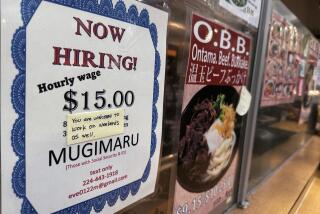U.S. jobless claims slow but underscore persistent weakness

As business reopenings picked up nationwide, nearly 2 million Americans filed applications for unemployment benefits last week, reflecting a slowing — though far from a halt — in job losses.
Initial jobless claims for regular state programs totaled 1.88 million in the week that ended May 30, Labor Department figures showed Thursday, down from 2.13 million the previous week. It was the first reading below 2 million since the coronavirus-related layoffs began en masse in mid-March. The median estimate in a Bloomberg survey of economists called for 1.83 million claims in the latest week.
Continuing claims — the total number of Americans claiming unemployment benefits — increased to 21.5 million in state programs the week that ended May 23, compared with analyst estimates for a decline. Most states reported declines from the week before, and the latest increase in part reflects quirks from biweekly filing rules in California, which showed an unadjusted rise of about 618,000.
The four-week moving average of continuing claims fell to 22.4 million from 22.7 million, the first decline of the pandemic.
“Looking at the broad contour, it still looks very much like continuing claims peaked in early May,” said Andrew Hollenhorst, chief U.S. economist at Citigroup Inc. “We’re not coming down strongly in any sense, but this notion that the bottom has hit in terms of how bad things will be in the labor market is increasingly coming through in the data.”
Meanwhile, consumer sentiment improved for a second week as Americans grew less pessimistic about their finances and the buying climate. Bloomberg’s Consumer Comfort Index rose 1.5 points to 37 in the last week of May. It was the biggest gain this year and just the third since the end of January.
In the week that ended May 30, 36 states reported 623,073 initial claims for Pandemic Unemployment Assistance, the federal program that extends unemployment benefits to those not typically eligible, including the self-employed. That was less than half the previous week’s count.
Thursday’s report underscores the current dichotomy in the labor market. The layoffs are continuing — and hitting the higher-wage workers and supervisors that escaped the initial wave of layoffs — but at the same time, a multitude of Americans have headed back to work with varying degrees of business restrictions being eased in all 50 states.
The initial claims figure remains enormous at about nine times the pre-pandemic weekly average, but weeks of decreasing initial claims suggests the worst of the coronavirus-related layoffs is over. Even so, lingering effects from forced business closures and the pandemic itself will probably weigh on any recovery in the labor market for some time.

The May jobs report, due out Friday, is forecast to show employers cut payrolls by 8 million, sending the unemployment rate soaring to Great Depression-like levels at 19.5%. It will also show the distribution of job losses across industries. The reference week for the report is in mid-May, so last week’s jobless claims may reflect job losses not captured in the monthly employment report.
California and Florida both saw increases of more than 27,000 in initial claims filed last week; Mississippi was the only other state to show a rise, though minuscule. States seeing significant jumps in continuing claims in the week that ended May 23 also included Texas, Pennsylvania, Oregon and Florida.
Georgia, one of the first states to reopen, saw its benefit rolls grow by 19,156 to 750,918.
The continuing claims numbers are “terrible but they’re not as terrible as they were,” said Ian Shepherdson, chief economist at Pantheon Macroeconomics. “The trend probably is still downwards, but you have to strip out these crazy numbers from California and Florida” that are resulting from biweekly filing, he said.
Given the unprecedented surge of claims in recent months, many economists look to the non-seasonally adjusted figures for a more accurate read on claims. The total reported number under the federal PUA and state programs was 2.23 million last week, down from 3.21 million the week before. Many states that have already accepted tens of thousands of claims for the federal assistance are still showing zero claims on the national report.
More to Read
Inside the business of entertainment
The Wide Shot brings you news, analysis and insights on everything from streaming wars to production — and what it all means for the future.
You may occasionally receive promotional content from the Los Angeles Times.










